#bolivian rainbow chilies
Text

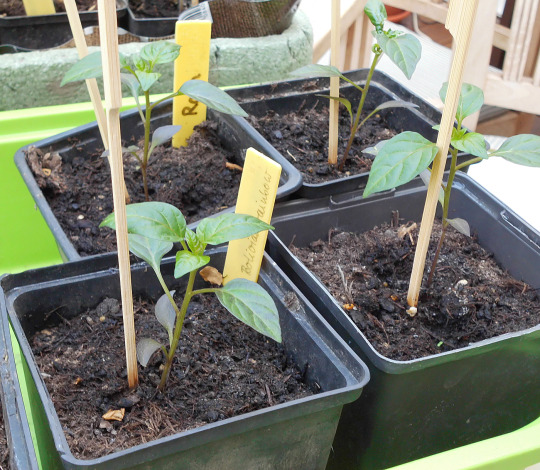
The chilies are growing! The new batch is still in small pots waiting to grow enough to go in a bigger one. This variant is called Bolivian Rainbow and they are a mild variety. The first picture is from a plant from a few years ago.
Unfortunately, the Trinidad Scorpion Yellow seeds did not sprout, probably because they were too old. They were part of my brother's legacy (this word is probably not the best choice, but....)
He was a scoville hunting maniac when it came to chilies and made arms-grade chili sauce for us to enjoy.
Yellow scorpion were my favourite variety of his collections because of their unique taste, so I am a bit sad they didn't sprout - also because chilies will forever be linked to him in my mind.
So, we'll grow only the rainbow chilies this year, because they look pretty and are a reminder of him. Maybe I will put one of the plants on his grave.
#chilies#bolivian rainbow chilies#trinidad scorpion chilli#Trigger warning death#arms-grade chilies#gardening#home grown food
12 notes
·
View notes
Text
Btw here are the list of holiday ingredients
Starlight bbq:
Smoked Cheddar Bun
Mac n' Cheese
Mambo Sauce
Powsicle Slush
Baked Beans
Lone Star Pit Sauce
Bavariafest:
Pretzel Bun
Sauerkraut
Bierkäse
Blockmalz Slush
Bratwurst
Marzen Mustard
Maple mornings:
Waffle
Hash Brown Patty
Maple Syrup
Cinnamon Swirl Slush
Sausage Patty
Hollandaise Sauce
Day of the dead:
Pan De Muerto Bun
Chicharrones
La Catrina Sauce
Chamoyada Slush
Tamalito
Mole Mística
Thanksgiving:
Frybread
Mashed Potatoes
Gravy
Pumpkin Spice Slush
Turducken
Wojapi Sauce
Christmas:
Jack Frost Bun
Canned Cranberry
Creamy Pistachio Sauce
Dr. Dasher Slush
Arugula Wreaths
Krampus Sauce
New years:
Rainbow Rye Bun
Bolivian Chiles
Wild Onion Sauce
Tutti Frutti Slush
Potato Chips
Midnight Marsala
Valentine’s Day:
Pink Poppyseed Bun
Radicchio
Heartbeet Arrabbiata
Hot Rods Slush
Prosciutto
Nogada Sauce
Lucky lucky matsuri:
Cheung Chau Bun
Lotus Root
Karashi Mayo
Iyokan Slush
Kimchi
Gochujang
Easter:
Pasqua Bun
Pickled Carrots
Wildflower Carbonara
Cotton Candy Slush
Mixed Microgreens
Blackberry Remoulade
Comet con:
Lunar Loaf Bun
Starfruit
Astro Elixir
Galaxy Grape Slush
Space Ration ZX26
Hyper Green Sauce
Summer luau:
Hawaiian Bun
Kalua Ham
Mango Chili Sauce
Luau Punch Slush
Grilled Plantains
Hula Hula Sauce
7 notes
·
View notes
Photo

Bolivian Rainbow Chili (at Göttingen) https://www.instagram.com/p/ChxWZOyLB_s/?igshid=NGJjMDIxMWI=
0 notes
Text
Yeah we all have brainrot, but do you have mad botanist brainrot?
So, I grow chili pepper plants as a hobby, and one of the things I like the most about it is the huge variety of plants you can get. This is just my harvest from last year, and I am pretty middle of the road.

And I did have an itching to start my own crossbreeding project, the actual planning of which coincided with the release of the funny pirate show.
And there are certain chili plants that I like to give to friends with goth-sensibilities, that grow very dark leaves and black fruit. There's also a type of chili pepper called The Scotch Bonnet. You can see where this is going. I could actually make a BlackBonnet plant. Let's all agree to stick with that shipname because this will take a couple years.
(ridiculous amount of info and pictures under the cut, this is partly for you and mostly for me)
"Surely," I thought "someone must have already made a BlackBonnet?" The Scotch Bonnets come in a huge variety, and chili enthusiasts like the Black Plants for their novelty. But no, the closest I can find is the 'Scotch Bonnet Guadalupe Black', which doesn't seem too popular and grows the usual green leaves. There are also a few 'chocolate' and 'brown' variants, but I believe we can go darker.
Anyway, these are the parents I'm working with:
"Scotch Bonnet Trinidad/ Trenton."
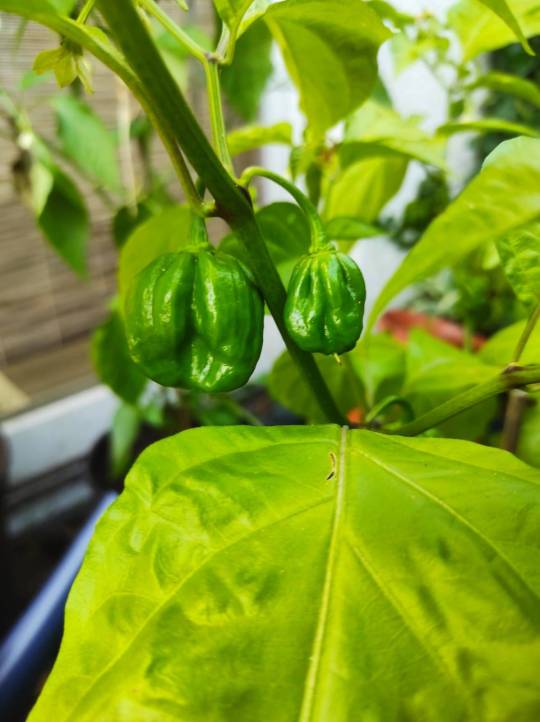

Scotch Bonnet chilis are a very popular, very hot variant of the type Capsicum Chinense. They come from the Caribbean but are named for the form of the fruit, which resembles the Scottish headwear.
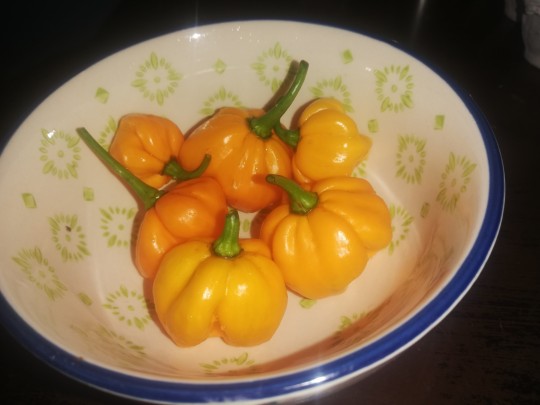
Your mileage may vary on how accurate that is.
As you can see even from my little potted plant, the SB are very high yield, and their hotness and fruity aroma make them popular for sauces and powders. I'm using the Trenton FM (Gelb) and Trinidad(Red).
"Long Black Chili"


Now this I got from a seller who doesn't have the best reputation for breed purity. And then I collected seeds for two generations after I didn't do anything to prevent crossbreeding with a variant called Bolivian Rainbow, also famous for its dark leaves. So there's a good chance there's already some variety in here.
Anyway, my guess is that it started as a variant of Zimbabwe Black, an aanum that is well known for growing very dark leaves and fruit that turn from black to a nice deep red.
"But tumblr user babtest", you say, since you have immediately spotted the problem in my plan. "Capsicum Chinense and Capsicum Annuum are notoriously hard to crossbreed! Why not use another Chinense?"
Well, because I hadn't planned this when I got my seeds last december. And who'd start another crop mid-april because of some fandom nonsense?
So I ordered some seeds for the Pimenta de Neyde.
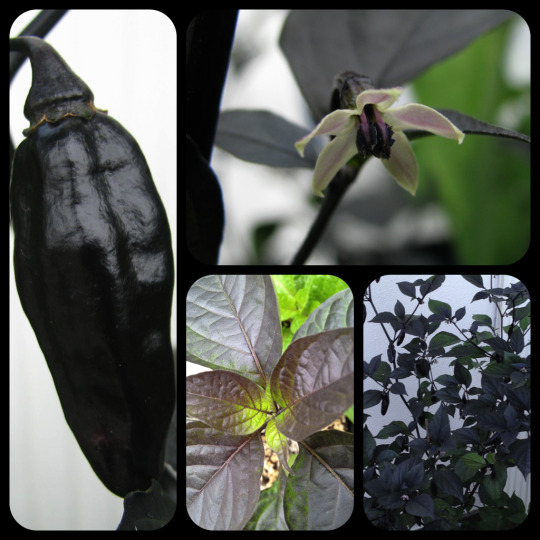
(Picture from Chilifee.de. Not the Seller i use, that'd be the amazing Semillas but the picture is a nice overview)
A beautiful dark Capsicum Chinense. We'll see how many I can actually grow this season, I'm only aiming to fill the two extra spots I have left on my windowsill, but it's a def. factor for next year.
Anyway, on the actual crossbreeding!
I'll be following this guide: https://www.fatalii.net/Growing_chile_peppers/Breeding
The goal: A Chili with dark leaves and stems, that grows black fruits in the typical round shape of a Scotch Bonnet.
'Male Parent' is the plant you take the pollen from, "Female Parent" is the one which germiates the seeds. The name for a new Breed is Female Parent x Male Parent so:
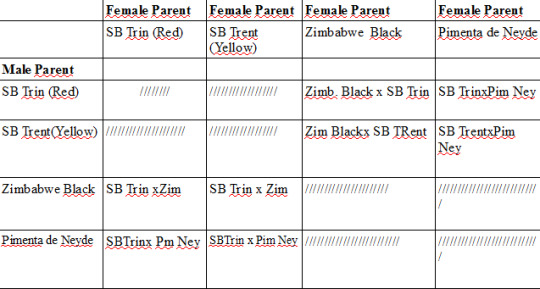
Oof, eight F1 (first generation hybrid) variants? I'll really need to step up my organisation game.
As far as I can tell, there's no majority opinion on which parents are more likely to retain which genes.
I'll be using both the SB Trenton (yellow) and SB trinidad (Red) because I have no clue which is more likely to take on the darker colours of the other parent plants.
There's also no telling how the fruits will turn out, so the first selection will be purely for leaf colour, then Fruit Colour and Shape. You keep the plants that show the attributes you want and collect seeds from them.
Since I'm selecting for several attributes (Plant colour, Fruit Shape, Fruit Colour), I might also crossbreed within the plants.
And as you know if you did Punnet squares, there's no guarantee that recessive genes won't come out in the 3rd and later Generations. So you rinse and repeat, select for attributes until the Breed is stabilized enough that (mutations notwithstanding) you get a reliable outcome. That averages between 5-15 generations. So. Not a short term project. But it's going to be fun.
And that is pretty much it. Yohoho, wish me luck.
#our flag means death#listen im only tagging this once for attention#the rest i'm just going to do sporadic updates we'll see how it goes#but i think it wil be fun#and if anyone within europe wants in hmu#this would be a nice project even without the show#but the connection makes it funnier
11 notes
·
View notes
Text
ORNAMENTAL PEPPER AND ITS TYPES
Ornamental pepper is a Christmas pepper plant that is also known as Ornamental pepper. Capsicum annuum cultivars is the scientific name for ornamental pepper.
They are members of the Solanaceae family. Although these plants are perennial veggies, they are frequently planted as annuals.
The ornamental pepper is a Central and South American native. USDA hardiness zones 9-11 are suitable for growing them. They can be used as both yard bedding plants and indoor houseplants.
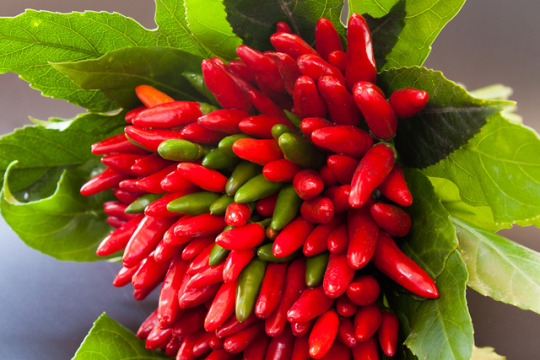
The vegetable garden is full of lovely and tasty plants. Reds, yellows, oranges, and purples of ripening fruits and vegetables often brighten up bouquets and gardens as much as they do our dinner plates, in addition to their culinary purposes.
Ornamental peppers, as they're known, give color to flowers and vase arrangements just as much as they do to our meals. The fruits and foliage of decorative peppers come in a wide range of colors and shapes.
Summer peppers are planted when the soil temperature reaches 70 degrees Fahrenheit in the spring. Pepper leaves are poisonous to both humans and animals.
Despite the fact that there are numerous species of pepper that are mostly utilized for culinary purposes, the variations planted as ornamental have been described in this article.
Varieties
There are both bright and colorful decorative peppers and darker and moodier tones. Some popular variations are listed below.
Chilly Chili
This type has long red and yellow peppers that grow straight from the plant's top, like fingers.

Black Pearl
As the name implies, this variety's purple leaves and dark fruits gleam like a pearl.
Aurora
When mature, this cultivar turns a rainbow of colors, starting with green, then purple, and finally orange and red in a single plant.
Bolivian Rainbow
This type features highly hot and spicy peppers that resemble Christmas light bulbs in appearance.
Sangria
This cultivar has a trailing habit and is an excellent choice for hanging baskets.
NuMex Easter
Pastels like peppers and bright green foliage make up this variety.
Orange Wonder
On a brilliant green plant approximately a foot tall, it produces conical orange peppers in the autumn and summer, among bushy foliage.
Conclusion
Brightly colored and sometimes tasteless ornamental peppers give startling beauty to the landscape or a pop of brilliance to indoor plants.
For their aesthetic value, most gardeners prefer to plant ornamental peppers in containers, both outside and indoors. The brightly colored plants in this category make outstanding landscape examples.
0 notes
Photo

Delicious Bolivian rainbow peppers. Mmmmm #bolivian #bolivianrainbow #pepper #chili #hotpepper #noms #redhot #growyourown #backyardgarden
0 notes
Text
Chilisamen, Bolivian Rainbow Chili Saatgut
http://j.mp/2QhvNij
0 notes
Photo
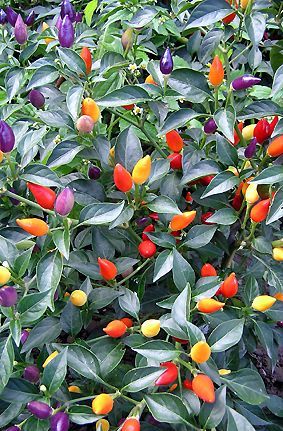
Flowers And Garden Ideas : Bolivian Rainbow Hot Chili Peppers – The chilies are very hot, so use them cauti… https://ift.tt/2oPE2m4
0 notes
Text
Cabe klassifikaasje Of Boliviaanske Rainbow Chili Rainbow
Classification Cabe Rainbow / Cabe Rainbow http://slosa.blogspot.com/2016/04/klasifikasi-cabe-pelangi-atau-bolivian-rainbow.html Sa seker jo nea sjogge de frucht is net chili kleur krongen, yep dat is chilli of oerli reinbôge reinbôge dat kaam út Súd-Amearika, dy chili as jonge grien kleure earder dan wyt, doe draaide om kleur pears en as al sean yn reade chilli Kayaking yn it algemien. Sa seker planters freonen wolle witte de klassifikaasje fan plant chilli of oerli reinbôge reinbôge is net it? check out.
Colorful chili ûntstiet út Súd-Amearika. Guon sizze fan Brazylje, ek al is it draait út syn echte namme: Boliviaanske Rainbow. Chili type wurdt faker brûkt as in sier plant, en wurdt ferkocht yn de online wrâld foar dy behoeften. Wêrom net fertarre, bygelyks foar in freon te iten fried foods?
Rainbow chilies chopped yn lytse stikjes mei fruit konfrontearre omheech. Dizze chili hat in grutter fruit en hie harvestable folwoeksenheid flugger as oare soarten fan peppers. Cabe Rainbow is geskikt foar brûkt wurde as in sier plant. Dizze chili wurdt luts wer ytbere middels dy't kin wurde fortard mei in frij hege mjitte fan spiciness. Wolle jo fiele de sensaasje fan dit unike sier chili? Kom kopen sied en it oanplantsjen fan it yn jo hûs. Meitsje dyn buorlju en kollega wiene ûnder de yndruk te sjen dyn rainbow oerli planten.
Wy sjogge de neikommende gegevens, ja:
* It nivo fan spiciness: 5000-30000 shu
* Heech trochsneed plant: 60-90cm
* It klimaat is ideaal: it leechlân - heech
* Sunlight: de hiele dei
* Media planting: tanah2: humus1
* Water ferlet: tuskenbeiden
* It tal fan sieden yn it pakket: 10pc
media planting
Planting medium wurdt makke út in mingsel fan Schote brânstof / raw rys Schote + grûn + dong, alle yngrediïnten wurde mingd en geande tegearre, of it kin wêze foar dy fan jimme, dy't net om de oanskaf fan sempet sa ek dêr, meastal op 'e pleats supply winkel. Allinnich dan set yn in plastic pot. minimal gebrûk fan plastic pot maat 25 sm.
Mute King goed foar peper plant, dêr moat wêze gatten yn de boaiem. De funksje is nei drain it wetter. Chili koe net groeie op waterige grûn, der moat wêze ôfwettering yn 'e pot planten.
It oanplantsjen seizoen.
Chilli zaden útdroegen troch sieden. Soak chili sieden yn waarm wetter foar 30 minuten, dan genieten yn kâld wetter nachts, dan ferspraat yn in pot dat hat folle de media, dan de media piled sa djip as 0,5 sm, Iram moarn en middei en soargje derfoar dat it wetter net stagnate. Sa'n 1-3 wiken shoots sil ferskine.
Sadree't de zaailingen hawwe maat 10 sm of 4-6 leafy, flower potten kinne wurde ferpleatst nei de al taret earder. De oerdracht moat foarsichtich net te skansearje de woartels en beamstammen. Ien kear op 'e beweging, krekt routine ûnderhâld Flushing, of as nedich wêze ditambahin dong. Op 'e moarn pleatst bûten it hûs.
By . Cara Menanam Hidroponik
Source: slosa.blogspot.com
0 notes
Text
classement Cabe Or bolivien arc-en-ciel Chili
Classification Cabe arc / Cabe arc http://slosa.blogspot.com/2016/04/klasifikasi-cabe-pelangi-atau-bolivian-rainbow.html donc certainement vous ne voyez jamais le fruit est pas de couleur de chili bondé, oui c'est le piment ou piment arc-en-ciel qui est venu de l'Amérique du Sud, ce piment si jeune de couleur verte plutôt que blanc, puis se tourna vers la couleur pourpre et si elle est déjà cuite au piment rouge kayak en général. Donc, certainement planteurs amis veulent connaître la classification de piment de la plante ou de piment arc-en-ciel est-ce pas? vérifier.
chili Colorful est originaire d'Amérique du Sud. Certains disent du Brésil, même si elle se révèle son vrai nom: Boliviano arc. type Chili est plus couramment utilisé comme plante ornementale, et est vendu dans le monde en ligne pour ces besoins. Pourquoi ne pas consommée, par exemple pour un ami de manger des aliments frits?
piments arc haché en petits morceaux avec des fruits vers le haut. Ce piment a un fruit plus grande et avait la maturité récoltable plus vite que d'autres types de poivrons. Cabe Rainbow est apte à être utilisé comme plante ornementale. Ce piment est tiré des moyens à nouveau comestibles qui peuvent être consommés avec un degré assez élevé de spiciness. Vous voulez vous sentir la sensation de ce piment ornemental unique? Venez graines acheter et planter dans votre maison. Créez vos voisins et collègues ont été impressionnés de voir votre arc plantes de piment.
Nous voyons les données suivantes, oui:
* Le niveau de spiciness: 5000-30000 SHU
* Plante moyenne: 60-90cm
* Le climat est idéal: les basses terres - haute
* Lumière du soleil: toute la journée
* Médias plantation: tanah2: humus1
* Les besoins en eau: modérée
* Le nombre de graines dans le paquet: 10pc
la plantation des médias
milieu de plantation est faite à partir d'un mélange de carburant brou / raw balle de riz + sol + fumier, tous les ingrédients sont mélangés et agités ensemble, ou il peut être pour ceux d'entre vous qui ne font pas l'achat sempet donc là aussi, le plus souvent au magasin de fournitures agricoles. Seulement puis mis dans un pot en plastique. utilisation minimale de plastique taille du pot de 25 cm.
Flowerpot bon pour l'usine de poivre, il devrait y avoir des trous dans le fond. Sa fonction est de drainer l'eau. Chili ne pouvait pas se développer sur le sol aqueux, il devrait y avoir le drainage dans les plantes en pot.
La saison de plantation.
graines de piment propagées par les semences. Faire tremper les graines de piment dans l'eau chaude pendant 30 minutes, puis faire tremper dans l'eau froide pendant une nuit, puis se propager dans un pot qui a rempli les médias, les médias empilés aussi profond que 0,5 cm, iram matin et après-midi et assurez-vous que l'eau ne stagne pas. Environ 1-3 semaines pousses apparaissent.
Une fois que les plants ont une taille de 10 cm ou 4-6 feuilles, des pots de fleurs peuvent être déplacés dans le déjà préparé plus tôt. Le transfert doit veiller à ne pas endommager les racines et les troncs d'arbres. Une fois sur le mouvement, le rinçage de l'entretien de routine juste, ou le cas échéant être ditambahin engrais. Le matin placé à l'extérieur de la maison.
By . Cara Menanam Hidroponik
Source: slosa.blogspot.com
0 notes
Text
Cabe luokitus Tai Bolivian Rainbow Chili Rainbow
Luokittelu Cabe Rainbow / Cabe Rainbow http://slosa.blogspot.com/2016/04/klasifikasi-cabe-pelangi-atau-bolivian-rainbow.html Joten varmasti et koskaan näe hedelmää chili väri tungosta, jep se chilillä tai chili sateenkaaren sateenkaaren, joka tuli Etelä-Amerikasta, tämä chili jos nuori vihreitä vaan sitten valkoinen, kääntyi sitten väri violetti ja jos jo keittää punainen chili melonta yleensä. Joten varmasti viljelijöiden ystävät haluavat tietää luokittelu kasvin chiliä tai chili sateenkaaren sateenkaari ei ole sitä? check out.
Värikäs chili peräisin Etelä-Amerikasta. Jotkut sanovat Brasilian, vaikka se kääntyy pois hänen oikea nimi: Bolivian Rainbow. Chili tyyppi on yleisesti käytetty koristekasvina, ja myydään online-maailmassa näiden tarpeisiin. Miksi ei kuluteta, esimerkiksi ystävä syödä paistettuja ruokia?
Rainbow chilit hienonnettu pieniksi paloiksi hedelmien ylöspäin. Tämä chili on suurempi hedelmä- ja oli pyyntikelpoinen kypsyyttä nopeammin muunlaisia paprikat. Cabe Rainbow soveltuu käytettäväksi koristekasvina. Tämä chili vedetään jälleen syötävä keinot, joita voidaan kuluttaa kanssa melko korkea mausteisuutta. Haluatko tuntea tunne tämän ainutlaatuisen koriste chili? Tule ostaa siemeniä ja istutus se kotona. Luo naapurit ja kollegat olivat vaikuttuneita nähdä sateenkaaren chili kasveja.
Näemme seuraavat tiedot, kyllä:
* Taso spiciness: 5000-30000 SHU
* Korkea keskimääräinen kasvi: 60-90cm
* Ilmasto on ihanteellinen: alanko - high
* Sunlight: koko päivän
* Media istutus: tanah2: humus1
* Vedentarpeet: kohtalainen
* Siementen lukumäärä pakkauksessa: 10kpl
media istutus
Istutus väliaine on valmistettu seoksesta kuori polttoaineen / raaka riisin kuori + maaperä + lanta, kaikki aineosat sekoitetaan ja sekoitetaan yhteen, tai se voi olla niille, jotka eivät tee osto sempet niin myös siellä, yleensä tilalla tarjonnan varastossa. Vasta sitten laittaa muovi potin. minimaalinen muovin käyttöä potin kokoa 25 cm.
Kukkaruukku hyvä pippuri kasvi, olisi reikiä pohjaan. Sen tehtävänä on valuttaa vettä. Chili ei kasva vetinen maaperä, olisi ojitus ruukkukasveja.
Istutuskauden.
Chilli siemenet lisättyjä kautta siemeniä. Liota chili siemenet lämpimässä vedessä 30 minuuttia, sitten liota kylmässä vedessä yön yli, sitten levisi ruukussa, joka on täynnä median, sitten media kasataan niin syvälle kuin 0,5 cm, IRAM aamulla ja iltapäivällä ja varmista, että vesi ei pysähdy. Noin 1-3 viikkoa versoja ilmestyy.
Kun taimet ovat kooltaan 10 cm tai 4-6 vehreässä, kukkaruukkuja voidaan siirtää jo valmis aikaisemmin. Siirto on varottava vahingoittamasta juuria ja puunrunkoja. Kun liikkeellä, juuri rutiinihuollon punoitus, tai tarvittaessa sen ditambahin lannoitetta. Aamulla Kodin ulkopuolelle sijoitetut.
By . Cara Menanam Hidroponik
Source: slosa.blogspot.com
0 notes
Text
Cabe uuri O Bolivian Rainbow Chili Rainbow
Classification Cabe Rainbow / Cabe Rainbow http://slosa.blogspot.com/2016/04/klasifikasi-cabe-pelangi-atau-bolivian-rainbow.html Kaya siguradong hindi mo makita ang mga prutas ay hindi chili kulay matao, yep na chilli o chilli rainbow rainbow na nagmula sa South America, ito chili kung batang berdeng kulay sa halip pagkatapos ay puti, pagkatapos ay lumipat sa kulay purple at kung mayroon na luto sa red chilli kayaking sa pangkalahatan. Kaya tiyak planters mga kaibigan na nais na malaman ang pag-uuri ng halaman chilli o chilli rainbow rainbow ay hindi ito? check-out.
Colorful chili nagmumula mula sa South America. Ang ilang mga sinasabi ng Brazil, kahit na ito ay lumiliko ang kanyang tunay na pangalan: Bolivian Rainbow. Chili type ay mas karaniwang ginagamit bilang isang bakong, at ipinagbibili sa mga online na mundo para sa mga pangangailangan. Bakit hindi natutupok, halimbawa para sa isang kaibigan na kumain ng pritong pagkain?
Rainbow chilies tinadtad sa maliliit na piraso na may prutas humarap sa itaas. chili na ito ay isang mas malaking prutas at nagkaroon harvestable kapanahunan mas mabilis kaysa sa iba pang mga uri ng peppers. Cabe Rainbow ay angkop na gagamitin bilang isang bakong. chili ito ay nakuha muli nakakain paraan na maaaring masunog sa isang medyo mataas na antas ng spiciness. Gusto mong pakiramdam ang pang-amoy ng mga ito natatanging pandekorasyon chili? Halika bili binhi at planting ito sa iyong bahay. Lumikha ng iyong mga kapitbahay at kasamahan ay impressed upang makita ang iyong bahaghari chilli halaman.
Nakakakita kami ng mga sumusunod na data, yes:
* Ang antas ng spiciness: 5000-30,000 SHU
* Mataas na average halaman: 60-90cm
* Ang klima ay ideal: ang lowlands - mataas na
* Sikat ng Araw: lahat ng araw
* Media planting: tanah2: humus1
* Water pangangailangan: moderate
* Ang bilang ng mga buto sa package: 10PC
media planting
Planting medium ay ginawa mula sa isang timpla ng upak fuel / raw rice upak + lupa + pataba, lahat ng mga sangkap ay halo-halong at hinalo magkasama, o maaaring ito ay para sa mga mo na hindi gumawa ng mga pagbili sempet kaya din doon, kadalasan sa tindahan farm supply. Tanging pagkatapos ay ilagay sa isang plastic palayok. minimal na paggamit ng plastic laki ng palayok 25 cm.
Paso mabuti para sa pepper plant, dapat ay mayroong mga butas sa ilalim. Its function ay upang alisan ng tubig ang tubig. Chili ay hindi maaaring lumago sa puno ng tubig lupa, doon ay dapat na drainage sa palayok halaman.
Ang planting season.
Chilli buto propagated sa pamamagitan ng buto. Magbabad chili buto sa maligamgam na tubig para sa 30 minuto, at pagkatapos ay ibabad sa malamig na tubig magdamag, pagkatapos ay kumalat sa isang palayok na mapuno nito ang media, at pagkatapos ay ang media nakasalansan bilang malalim bilang 0.5 cm, iram umaga at hapon at siguraduhin na ang tubig ay hindi tumimik. Humigit-kumulang 1-3 linggo shoots ay lilitaw.
Kapag ang mga seedlings ay may sukat 10 cm o 4-6 malabay, mga paso maaaring ilipat papunta sa naka-handa nang mas maaga. Ang paglipat ay dapat na maingat na hindi makapinsala sa Roots at tree trunks. Sa sandaling sa ilipat, lamang routine maintenance flushing, o kung kailangan ay ditambahin pataba. Sa umaga nakalagay sa labas ng bahay.
By . Cara Menanam Hidroponik
Source: slosa.blogspot.com
0 notes
Text
Cabe klassifikatsiooni või Boliivia Rainbow Tšiili Rainbow
Klassifikatsioon Cabe Rainbow / Cabe Rainbow http://slosa.blogspot.com/2016/04/klasifikasi-cabe-pelangi-atau-bolivian-rainbow.html Nii kindlasti kunagi ei näe puu ei chili värvi täis, eks see chilli või chilli vikerkaar vikerkaar, mis oli pärit Lõuna-Ameerikast, see punane, kui noor roheline värviline pigem siis valge, siis pöördus värv lilla ja kui juba keedetud punane tšilli süsta- üldiselt. Nii kindlasti istutus sõbrad tahavad teada klassifitseerimise taime chilli või chilli vikerkaar vikerkaar kas pole? kontrollida.
Värvikad tšilli pärineb Lõuna-Ameerikast. Mõned ütlevad, Brasiilia, kuigi selgub tema tegelik nimi: Boliivia Rainbow. Tšiili tüüp on rohkem levinud ilutaimede ja müüakse võrgumaailmas neile vajadustele. Miks ei tarbita, näiteks sõbrale süüa praetud toidud?
Rainbow vürtsikaid hakitud väikesteks tükkideks puu ülespoole. See chili on suurem puu- ja oli raieküpse küpsuse kiiremini kui muud liiki paprika. Cabe Rainbow on sobilik kasutada ilutaimede. See chili tõmmatakse jälle söödavad vahendeid, mida saab tarbida üsna suur vürtsikus. Tahan tunda tunne see ainulaadne dekoratiivne chili? Tule osta seemne ja istutusmaterjali ta oma kodus. Loo oma naabritega ja kolleegid olid muljet, et näha oma vikerkaare chilli taimed.
Näeme ka järgmised andmed, jah:
* Vürtsikus: 5000-30000 SHU
* Kõrge keskmine taim: 60-90cm
* Kliima on ideaalne: madalikud - kõrge
* Päikesepaiste: kogu päev
* Meedia istutamine: tanah2: humus1
* Vesi vajadused: mõõdukas
* Seemnete arv pakis: 10pc
meedia istutamine
Istutamine keskmise valmistatakse segust väliskest kütuse / toores riis, tera + muld + sõnnik, kõik koostisosad segatakse ja segatakse kokku, või see võib olla neile, kes ei tee ostes sempet nii ka seal, tavaliselt talus poest. Ainult siis pane plastikust potti. minimaalne kasutamine plastikust pott suurus 25 cm.
Lillepott hea pipra taime, tuleks augud põhjas. Selle ülesanne on äravoolu vesi. Chili ei kasva vesine pinnas, seal peaks olema drenaaž potitaimed.
Istutamist.
Chilli seemneid paljundatakse seemnetega. Leota tšilli seemned soojas vees 30 minutit, seejärel leotada külmas vees üleöö, siis levis potti, mis on täidetud meedias, siis meedia kuhjatud nii sügavale kui 0,5 cm, IRAM hommikul ja õhtul ja veenduge, et vesi ei jääks seisma. Umbes 1-3 nädalat võrsed ilmuvad.
Kui seemikud on suurus 10 cm või 4-6 lehtedes, lillepotid saab kolis juba varem valmistatud. Ülekanne peab olema ettevaatlik, et mitte vigastada juuri ja puutüvedel. Kui liikvel, lihtsalt hooldust punetus, või vajaduse korral ditambahin väetist. Sisse hommikul paigutatud väljaspool kodu.
By . Cara Menanam Hidroponik
Source: slosa.blogspot.com
0 notes
Photo

Bolivian Rainbow Chili 🌶 https://www.instagram.com/p/Cg995vqrHxP/?igshid=NGJjMDIxMWI=
0 notes
Photo

POV: I invite you over to a nice pasta dinner, but instead of an elaborate sauce, the table is set with one giant bowl of tagliatelle, a lot of spice shakers, and this magnificent monstrosity.
“Say when,” I say, as I start pouring chili-oil from the teapot straigt onto your pasta. “It’s Bolivian Rainbow. I grew it myself.”
1 note
·
View note
Text
Cabe classification Or Bolivian Rainbow Chili Rainbow
Classification Cabe Rainbow / Cabe Rainbow http://slosa.blogspot.com/2016/04/klasifikasi-cabe-pelangi-atau-bolivian-rainbow.html So definitely you never see the fruit is not chili color crowded, yep that's chilli or chilli rainbow rainbow that came from South America, this chili if young green colored rather then white, then turned to color purple and if already cooked in red chilli kayaking in general. So definitely planters friends want to know the classification of plant chilli or chilli rainbow rainbow is not it? check out.
Colorful chili originates from South America. Some say of Brazil, even though it turns out his real name: Bolivian Rainbow. Chili type is more commonly used as an ornamental plant, and is sold in the online world for those needs. Why not consumed, for example for a friend to eat fried foods?
Rainbow chilies chopped into small pieces with fruit facing upwards. This chili has a larger fruit and had harvestable maturity faster than other kinds of peppers. Cabe Rainbow is suitable to be used as an ornamental plant. This chili is pulled again edible means that can be consumed with a fairly high degree of spiciness. Want to feel the sensation of this unique ornamental chili? Come buy seed and planting it in your home. Create your neighbors and colleagues were impressed to see your rainbow chilli plants.
We see the following data, yes:
* The level of spiciness: 5000-30000 SHU
* High average plant: 60-90cm
* The climate is ideal: the lowlands - high
* Sunlight: all day
* Media planting: tanah2: humus1
* Water needs: moderate
* The number of seeds in the package: 10pc
Growing media
Planting medium is made from a mixture of husk fuel / raw rice husk + soil + manure, all the ingredients are mixed and stirred together, or it can be for those of you who do not make purchasing sempet so also there, usually at the farm supply store. Only then put in a plastic pot. minimal use of plastic pot size 25 cm.
Flowerpot good for pepper plant, there should be holes in the bottom. Its function is to drain the water. Chili could not grow on watery soil, there should be drainage in the pot plants.
The planting season.
Chilli seeds propagated through seeds. Soak chili seeds in warm water for 30 minutes, then soak in cold water overnight, then spread in a pot that has filled the media, then the media piled as deep as 0.5 cm, iram morning and afternoon and make sure the water does not stagnate. Approximately 1-3 weeks shoots will appear.
Once the seedlings have size 10 cm or 4-6 leafy, flower pots can be moved into the already prepared earlier. The transfer must be careful not to damage the roots and tree trunks. Once on the move, just routine maintenance flushing, or if need be ditambahin fertilizer. On the morning placed outside the home.
By . Cara Menanam Hidroponik
Source: slosa.blogspot.com
0 notes